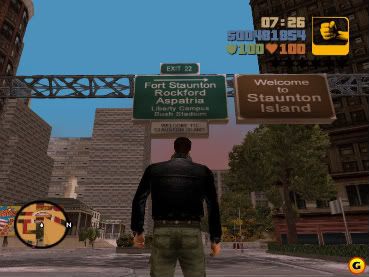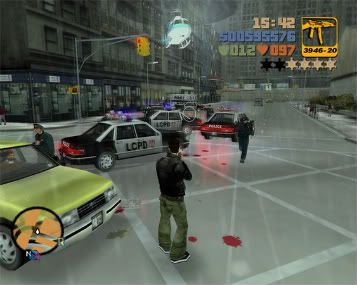
After several years away, it felt great to be back in GTA III's Liberty City. Despite the aging technology, Rockstar North's level of ambition regarding scale and verisimilitude is still very apparent, as is the definite sense of style and atmosphere not least communicated through the radio stations. Unglamorous and gray as it is, the lower opening section of the game somehow remains a joy to explore, and the extreme refinement of the vehicle physics is an immediate factor of immersion. It was pretty obvious to me that I wasn't going back to this game for its characters (although I was curious about how it handled story), but I was pleased to see that the level of polish that Rockstar's cinematics have become famous for was already burgeoning, and unveiling the "colorful" cast was a motivation for quickening progress. And so, with the easy money pouring in, the jobs breezy, diverse and all over the map, I could say I was promptly hooked. My first sessions with the game consisted of playing two to three hours on end with a big grin on my face.
Playing Bully, however, was a different story. It's not that I found the game dull or uninvolving, but I simply didn't feel the need to play it for long stretches like I did with its older cousin. And it's not either that I felt the game wasn't deserving of my interest, but rather that there was an internal factor at play that managed to put some order into GTA's intrinsic anarchy, and effectively divided game time into more meaningful chunks ; that factor being the passing of the school days. As simple as it is, this important element had the psychological effect of restraining my game behaviour and giving me a sense of purpose. And as paradoxical as it may seem, I actually liked this very much, feeling that I was getting similar amounts of gaming satisfaction in shorter periods, as well as being immersed in the discrete time-flow of the game. Add to this the interesting characters and well-directed cutscenes, great controls and engrossing atmosphere, and you had a recipe for a good time. But still, an element of playfulness and abandon was missing from what remained a pretty straightforward experience, and breaking the rules just wasn't doing the trick.
A few days with both games passed, and GTA III casually started to make me fail missions on repetition, linger for too long in the same areas and shout things that my mother wouldn't have liked to hear. It started to rub me the wrong way, often imposing completely unfair success criteria and narrow margins of error, at the same time that the narrative was growing into a clutter of trivial non-sense. Although the driving itself never got old, I began looking for the fun I remembered not only from this game, but also from subsequent titles in the series. "Why the heck is this game punishing me so hard for my mistakes?", I found myself asking as I was submitting to its mind-melting cycle of try-fail-repeat-fail-repeat-fail-SUCCEED. "How did the developers fail to see that something was wrong here?", was another of my frequent thoughts. And perhaps most confusing of all... "why am I still playing?".
This last question is especially tough, because it calls attention to the mysterious psychology of gaming and its infinite variables, the case of GTA being further complicated by its clash of wildly successful game systems and other, infuriating aspects. Thus the debate turns to how much crap a player is willing to endure, as long as he or she gets what satisfies him or her in the end. And although the subsequent entries in the series would expand the possibilities considerably, the fact remains that the gameplay offered by GTA III stands surprisingly limited, at least by today's standards ; to be blunt, you better learn to love driving at high speed, getting lost in twisty passages and looking for hidden items, or else you risk not finding much to your liking in there (especially not the shooting action). The greater potential of this basic formula is not helped either by the game's constraining mission structure: when meeting up with an employer, you deliberately choose to surrender your essential freedom as a player and to embark on a set challenge, if only to have some concrete goal to pursue. It is only fair, then, that the game fulfills its part of the contract by playing straight, which it often does not. It doesn't help, finally, that the narrative develops in unsatisfactory fashion, leaving story threads unresolved and switching allegiances in seemingly random manner, offering no significant way to spend the considerable money rewards and no solid human bonding over the span of the storyline. With all of this in mind, it bears mentioning that a study of this game's overlying and sometimes paradoxical anarchy from an economic angle would probably prove to be very interesting (heads-up are welcome).
Arriving several years after Grand Theft Auto III and even after the excellent San Andreas, Rockstar Vancouver's Bully resolves several of its landmark predecessor's conflicts in appealing ways. Starting with a somewhat compact play area, it ultimately opens up a world smaller than that of the GTA titles, albeit in more numerous stages (and thus in more directed fashion). This smaller scale allows the territory to be denser and more detailed, as well as to pack more personality ; a "personality bonus" that transfers to the characters, which are limited in number, recurrent and easily recognizable, giving the impression that the main character is part of a consistent social environment (which cannot be said of GTA). On another topic, developments to the RenderWare engine and overall technology have allowed the developers to allow for a far greater number of in-game activities. The team doesn't stop, however, at randomly mixing lawn-mowing with flirting and bike racing ; the distinct interactions are embedded into the overall game structure, some of them even facilitated by participating in the various classes (simultaneously giving relevance to the school setting). And finally, what I find most fascinating about this game is how the randomly-spawned non-player characters will tend to engage in certain social behaviours (fights, mostly) absolutely on their own, with no intervention on the player's part. If I had to name one aspect of the game that best illustrates all of these strands, it would be how it handles virtual photography, but I may leave that for another post...
There are, however, a handful of shortcomings that keep Bully from realizing its full potential as an interactive experience, the main one being its firmly-rooted amorality. Because even despite its nuances and improvements on the GTA formula, the game's core structure and objectives remain the same as that of Rockstar's bigger property. The main character still bows and accepts tasks from every denizen, each one allegedly bringing the hero closer to realizing his dream of social domination and independence. Some smaller "errands", in this regard, are especially disturbing: to deliver flowers right after shoving a couple of students in garbage cans is unsettling on a surface level, but the similar cash rewards and absence of consequences good or bad frees the avatar (and thus the player) of any moral sense. The activation of the story nodes also asks of the player to accept that certain narrative developments have occurred when he was not looking, which is odd because the way the game is presented leads the player to assume that he is controlling Jimmy in real-time, all the time. What all of this ultimately adds up to, in a frankly disappointing way, is that it prevents the user to play "in character", as well as to choose how he wishes that character to be. Now about ten hours in, I have tried to make Jimmy into a fairly nice boy, but the game authors seemingly have another way of seeing things, and I am not sure I like where the story is going (although L.B. Jeffries, taking from his personal life experience, makes a strong case for this idea of an imposed role in his excellent essay from the Well Played 1.0 anthology).
In a future post, I might dare the unspeakable and propose ways in which I think that a game like Bully could become a much more compelling "interactive computer program", would the developers approach it with the right mindset. It is also in full conscience that I recognize the growth of the open-world formula since the days of Grand Theft Auto III, which still remains a towering achievement of video game design. Exploring these games now, I am simply let down by how they ultimately seem to punish further and deeper investment on the player's part, rather than emotionally reward it as they rightfully should. Sure the game worlds are humongous, and navigating them is exhilarating ; but at the end of the day, these universes free of moral imperatives come off as little more than stages for enacting power fantasies, and the digital people filling them do not resonate as anything other than hollow satirical shells of human archetypes. I wish for more and I am sure I am not alone, and what these games do is tease the masses with tantalizing bits while failing to deliver on their promises. The least we can do, at least for now, is dream of a more complete package.
EXP Podcast #789: The Game Awards 2025 Announcements
23 hours ago
No comments:
Post a Comment